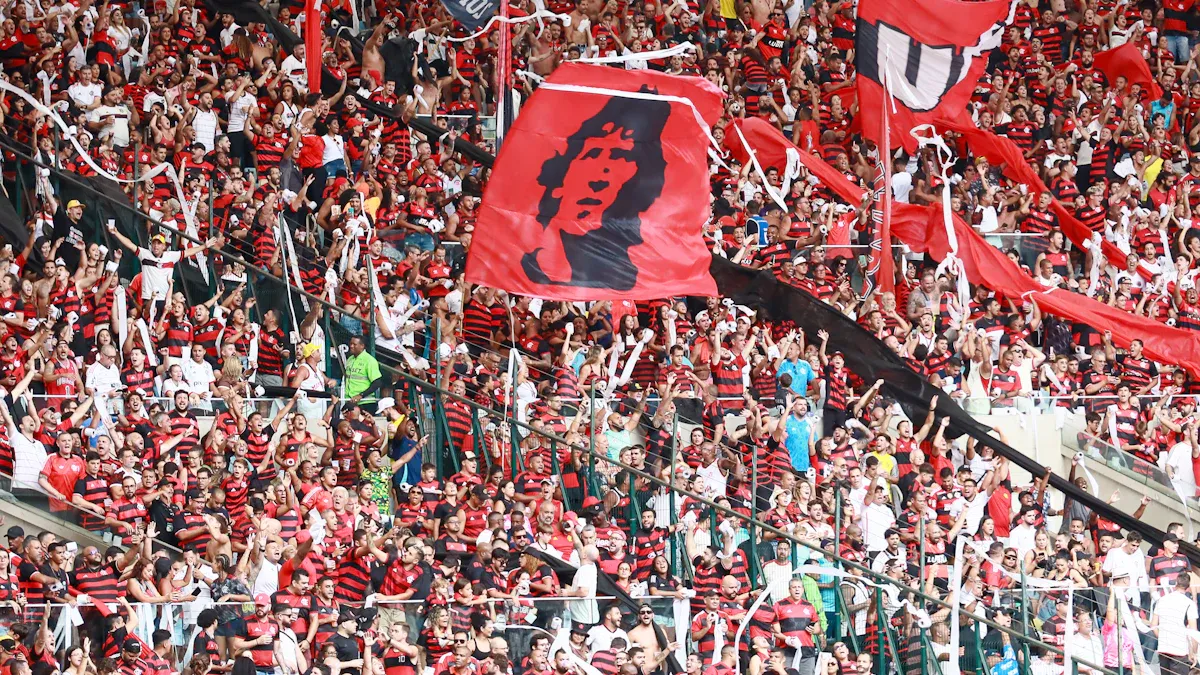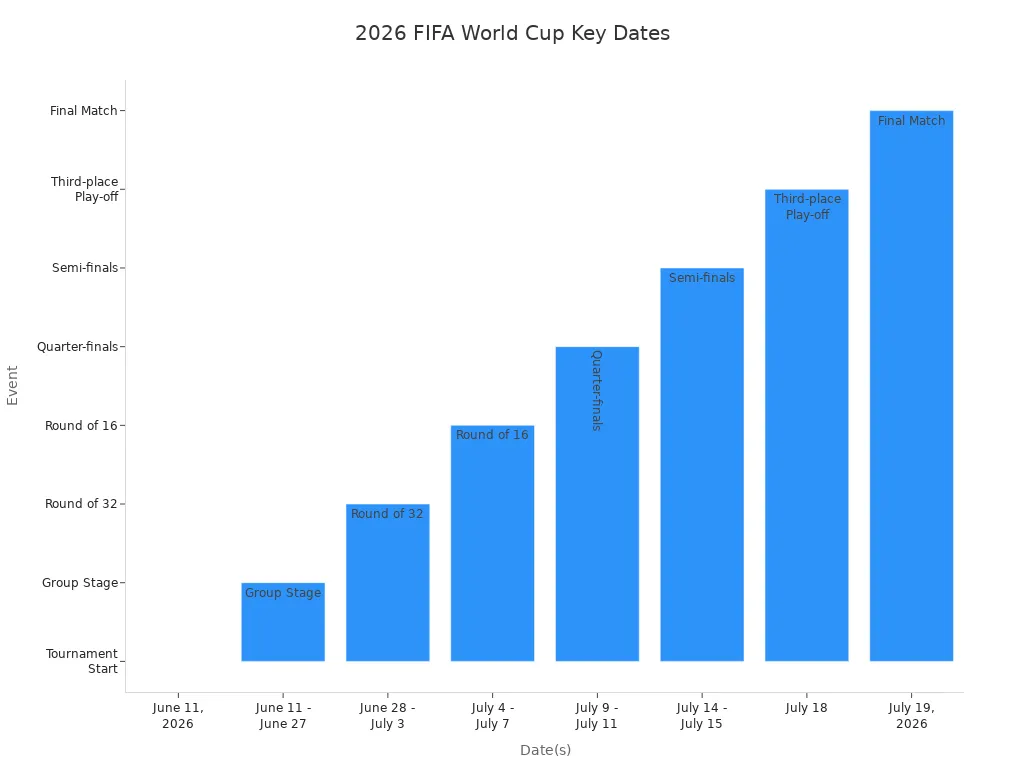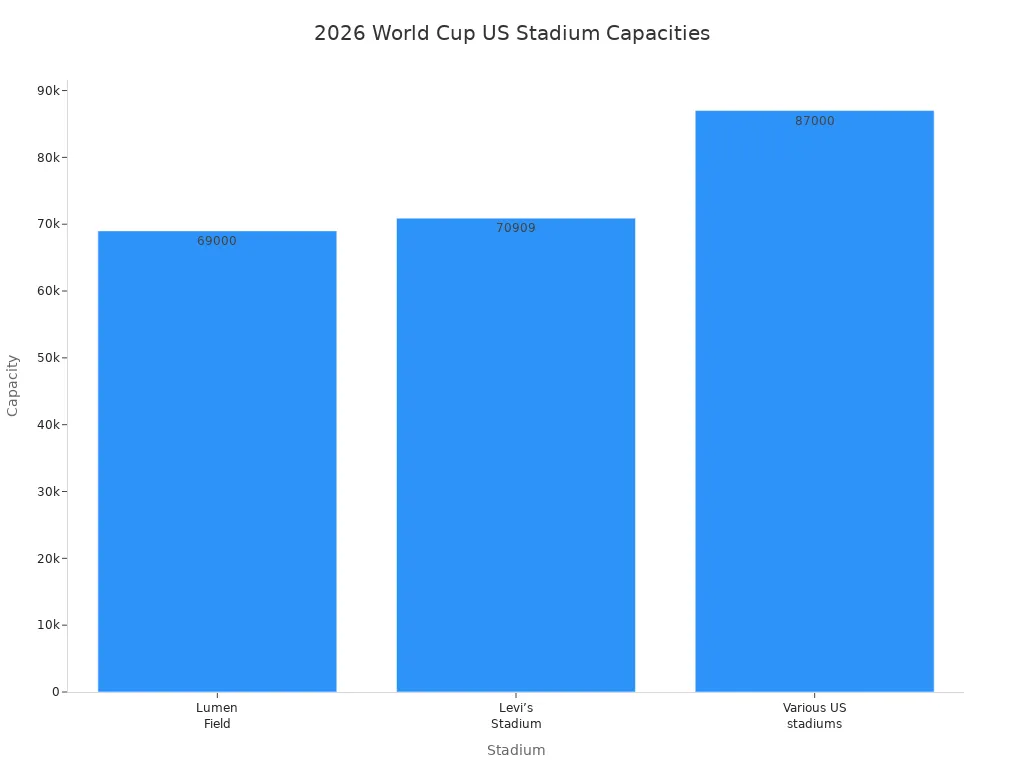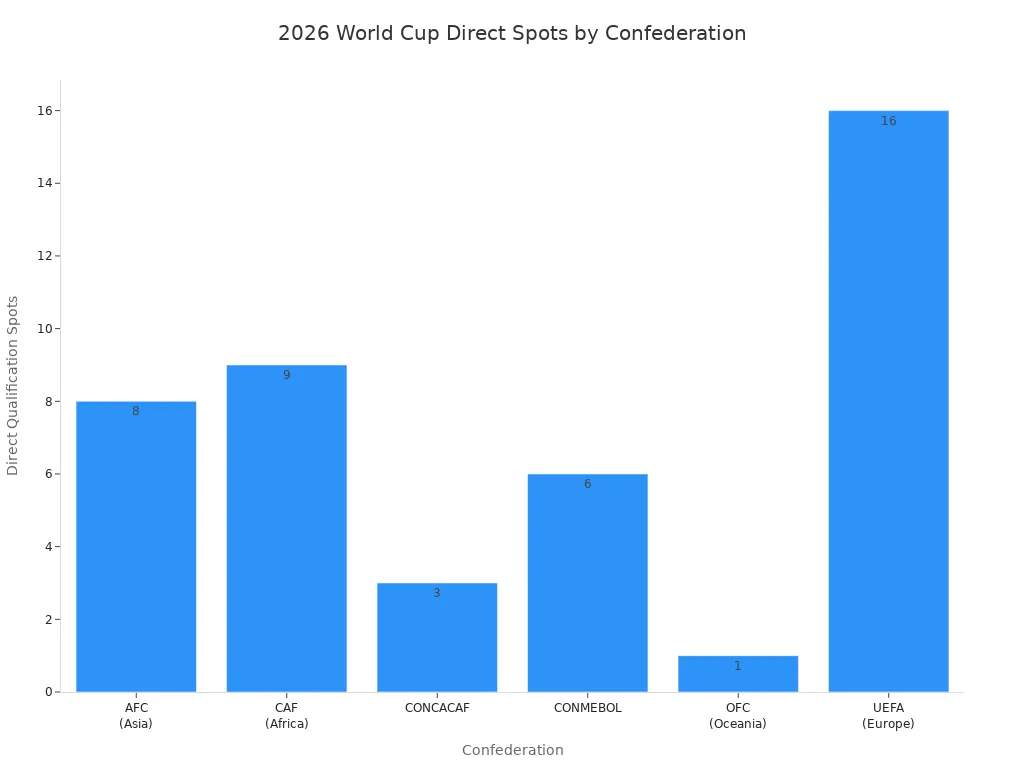
The 2026 World Cup will have 48 teams. Millions of fans will come to the United States, Canada, and Mexico. Cities think about 5 million visitors will arrive from other countries. This will help hotels, restaurants, and local shops make more money. The table below gives some important facts:
|
Aspect |
Details |
|---|---|
|
Teams |
48 |
|
Host Countries |
USA, Canada, Mexico |
|
Economic Impact |
$5–6 billion |
|
Traveling Fans |
5 million |
Fans and dealers can keep up by checking news and looking at special merchandise. If you want to know more, contact us.
Key Takeaways
-
The 2026 World Cup will have 48 teams. There will be 104 matches in 16 cities. These cities are in the USA, Canada, and Mexico. This will be the biggest tournament ever.
-
Tickets will be sold starting September 10, 2025. You can get them through a lottery system. Fans should sign up early. Only buy tickets from official FIFA sources. This helps you avoid scams.
-
Host cities have modern stadiums with lots of seats. They also have special features. There are fun local attractions and fan events. These make the experience better.
-
Fans should plan travel and places to stay early. Use public transit to get around. Be ready for security checks. This will help you have a safe and easy visit.
-
Dealers can sell more by offering custom, eco-friendly merchandise. They should use social media and events. This helps them connect with fans during the World Cup.
2026 World Cup Schedule

Key Dates
The 2026 World Cup starts on June 11, 2026. The first match will be in Mexico City. The tournament will last for more than a month. The last match will be at MetLife Stadium in New Jersey on July 19, 2026. There will be 104 matches in total. This is 40 more matches than before. The group stage goes from June 11 to June 27. After that, the knockout rounds begin. The Round of 32 starts on June 28. The final match will be in July.
|
Event |
Date(s) |
Location(s) |
|---|---|---|
|
Tournament Start |
June 11, 2026 |
Opening match in Mexico City |
|
Group Stage |
June 11 – June 27 |
Various venues in USA, Canada, Mexico |
|
Round of 32 |
June 28 – July 3 |
Various venues |
|
Round of 16 |
July 4 – July 7 |
Various venues |
|
Quarter-finals |
July 9 – July 11 |
Various venues |
|
Semi-finals |
July 14 – July 15 |
Various venues |
|
Third-place Play-off |
July 18 |
Various venues |
|
Final Match |
July 19, 2026 |
MetLife Stadium, East Rutherford, New Jersey |

The 2026 World Cup will use a new format. There will be 48 teams in 12 groups. Each group has four teams. The top two teams in each group move on. The eight best third-place teams also move to the Round of 32. The winner will play eight matches. This is one more match than before.
Host Cities
Sixteen cities in the United States, Mexico, and Canada will have matches. Fans from all over the world will visit these cities. The list below shows the host cities and their stadiums:
|
Country |
Host Cities (Stadiums) |
|---|---|
|
USA (11) |
Atlanta (Mercedes-Benz Stadium), Boston (Gillette Stadium), Dallas (AT&T Stadium), Houston (NRG Stadium), Kansas City (Arrowhead Stadium), Los Angeles (SoFi Stadium), Miami (Hard Rock Stadium), New York/New Jersey (MetLife Stadium), Philadelphia (Lincoln Financial Field), San Francisco (Levi’s Stadium), Seattle (Lumen Field) |
|
Canada (2) |
Toronto (BMO Field), Vancouver (BC Place) |
|
Mexico (3) |
Guadalajara (Estadio Akron), Mexico City (Estadio Azteca), Monterrey (Estadio BBVA) |
Many cities think they will get more money from visitors. Houston will have seven matches and a 39-day FIFA Fan Festival. Local shops and restaurants will get more customers and more attention from other countries.
Match Locations
The stadiums for the 2026 World Cup are very modern. Each stadium has special features and lots of seats. Here are some of the most important stadiums:
-
BC Place (Vancouver, Canada): Has a roof that opens and closes, new technology, and will have 7 matches.
-
Lincoln Financial Field (Philadelphia, USA): Seats 69,000 people, has new features, and will have 6 matches.
-
Hard Rock Stadium (Miami, USA): Seats about 65,300 people, was fixed up recently, and will have 7 matches including a quarterfinal and the third-place playoff.
-
Gillette Stadium (Boston, USA): Seats 68,000 people, has fancy suites, and will have 7 matches.
|
Stadium Name |
Location |
Seating Capacity (Expandable) |
|---|---|---|
|
Levi’s Stadium |
San Francisco, USA |
68,500 (up to 75,000) |
|
NRG Stadium |
Houston, USA |
71,795 (up to 72,220) |
|
Hard Rock Stadium |
Miami, USA |
64,767 (up to 67,518) |
|
Mercedes-Benz Stadium |
Atlanta, USA |
71,000 |
|
Lumen Field |
Seattle, USA |
69,000 (up to 72,000) |
|
Gillette Stadium |
Boston, USA |
65,878 (up to 70,000) |
|
AT&T Stadium |
Dallas, USA |
80,000 |
|
MetLife Stadium |
New York, USA |
82,500 (up to 87,157) |
|
BMO Field |
Toronto, Canada |
30,000 (up to 45,000) |
|
Estadio Akron |
Guadalajara, Mexico |
46,232 |
|
Estadio BBVA |
Monterrey, Mexico |
53,500 |
|
Estadio Azteca |
Mexico City, Mexico |
87,523 |

All host cities will have group stage matches. The biggest stadiums will have the knockout rounds. The final match will be at MetLife Stadium. This stadium can hold more than 82,000 fans. There will be 104 matches in total. This will be the largest World Cup ever.
Latest News
Ticketing
Fans really want tickets for the 2026 World Cup. Ticket sales start on September 10, 2025. Organizers will use a lottery to give out regular tickets. Fans need to sign up and ask for tickets. If picked, they can buy tickets before others. Tickets will not be sold at stadiums. Premium ticket packages in cities like Seattle cost at least $1,575 each. Hospitality suites cost about $1,350 to $1,500 per person. Only people 18 or older can buy tickets. The event will happen in 16 cities and about 6.5 million people are expected to come.
|
Aspect |
Details |
|---|---|
|
Ticket Sales Start Date |
September 10, 2025 |
|
Sales Process |
Registration and lottery; sales in phases |
|
Ticket Purchase |
First come, first served after selection |
|
Age Requirement |
18+ years |
|
Premium Packages |
Start at $1,575 per person in some cities |
|
Expected Attendance |
6.5 million |
|
Tournament Dates |
June 11 to July 19, 2026 |
Tip: Fans should sign up early and check for news to get their seats.
Hospitality
Hospitality packages give more than just a seat at the match. These packages have special seats, private lounges, and fancy food and drinks. The Trophy Lounge has great sideline seats, snacks, and a menu from local chefs. VIP packages add city-themed fun and live shows. Pitchside Lounge has top seats, cool drinks, and visits from special guests. Hospitality packages start at about $2,500 and can go up to $73,000 for the best ones. Some packages also have parking and help from staff.
Special Events
Cities will have special events for the 2026 World Cup. Seattle Center will welcome up to 750,000 fans for a big party. The event will show live matches, local food, music, and fun activities about Seattle’s culture. Nine more fan zones in Washington will let more people join the fun. New York City will have watch parties and events by the water. These parties will help local shops and make fans excited.
Venues

Stadiums
The 2026 World Cup will be in very modern stadiums in North America. These places have new technology and lots of seats. Each stadium has something special. Many have held big sports events before, like the Super Bowl or Copa America. Some stadiums have roofs that can open and close. Others are built to help the environment. Levi’s Stadium in the San Francisco Bay Area has a farm on its roof and fast Wi-Fi. Lumen Field in Seattle is known for being very loud and is near downtown.
|
Stadium Name |
Location |
Inauguration Year |
Capacity |
Home Teams |
Key Features and Notes |
|---|---|---|---|---|---|
|
Lumen Field |
Seattle, WA |
2002 |
69,000 |
Seahawks, Sounders, OL Reign |
Partial roof, downtown location, hosted Copa America and Gold Cup |
|
Levi’s Stadium |
San Francisco Bay Area |
2014 |
70,909 |
49ers |
LEED Gold certified, rooftop farm, hosted Super Bowl, tech upgrades |
|
MetLife Stadium |
New York/New Jersey |
2010 |
82,500 |
Giants, Jets |
Hosts the final, close to Manhattan, large video boards |
|
Estadio Azteca |
Mexico City |
1966 |
87,523 |
Club América, Cruz Azul |
Hosted two World Cup finals, rich history, vibrant atmosphere |
|
BC Place |
Vancouver |
1983 |
54,500 |
Whitecaps FC |
Retractable roof, scenic views, focus on sustainability |

Many stadiums use clean energy and try to make no waste. Cities like Vancouver and Seattle are leaders in being green.
City Highlights
Every host city has cool things to see and do. Fans can have fun with more than just soccer.
-
New York City has famous museums, Broadway, and the Statue of Liberty.
-
Toronto has the CN Tower, many cultures, and fun festivals.
-
Mexico City has a historic center, tasty street food, and mariachi music.
-
Guadalajara is where mariachi and tequila started.
-
Kansas City is known for BBQ and jazz music.
-
Vancouver has mountains, the ocean, and outdoor fun.
-
Miami is famous for its nightlife and Cuban culture.
-
San Francisco Bay Area has the Golden Gate Bridge and wine country nearby.
These cities mix soccer fun with local food, music, and history.
Travel Tips
Fans should get ready early for a great World Cup trip.
-
Book hotels or rentals early because many people will visit.
-
Stay in places like Polanco or Condesa in Mexico City for easy travel.
-
Use buses or metro lines to get to stadiums. Many cities let you pay with a card or phone.
-
Give yourself extra time on match days because of traffic and crowds.
-
For far cities, flying is fastest. For close cities, trains and buses are good.
-
Only buy tickets from FIFA to stay safe from scams.
-
Pack for different weather and learn some Spanish for Mexico.
-
Security will be tight, with bag checks and checkpoints at stadiums. Fans should listen to staff and come early.
-
Many cities will have fan parties and cultural events, so fans can enjoy local life and meet others.
Tip: Being green is important. Fans can help by using public transit, recycling, and supporting eco-friendly ideas in each city.
Format & Teams
Tournament Structure
The 2026 World Cup will use a new format.
-
There will be 48 teams instead of 32. This makes it the biggest World Cup ever.
-
Matches will happen in 16 cities in the United States, Canada, and Mexico. This is the most spread-out World Cup so far.
-
The group stage has 12 groups. Each group has four teams. The top two teams in each group move on. The eight best third-place teams also move to the next round.
-
There will be 104 matches instead of 64. Fans get to watch more games and see more surprises.
-
For the first time, the World Cup final will have a halftime show. This gives fans extra fun during the big game.
-
Organizers want to help the planet. They use stadiums that save energy and new technology like better VAR systems.
More countries can play in this World Cup. This means new teams and stories for everyone to enjoy.
Qualification
Teams from all over the world try to get into the 2026 World Cup. Each region has its own way to pick teams.
Here is a table that shows how many teams can qualify from each confederation:
|
Confederation |
Direct Qualification Spots |
Inter-Confederation Play-off Spots |
Notes |
|---|---|---|---|
|
AFC (Asia) |
8 |
1 |
|
|
CAF (Africa) |
9 |
1 |
|
|
CONCACAF |
3 |
2 |
Hosts USA, Canada, Mexico qualify automatically |
|
CONMEBOL |
6 |
1 |
|
|
OFC (Oceania) |
1 |
1 |
|
|
UEFA (Europe) |
16 |
0 |

Each confederation uses its own rules. Some use groups where everyone plays each other. Others use knockout games to pick who moves on.
Star Players
Many young players are ready to show their skills at the 2026 World Cup.
-
Kylian Mbappé is fast and talented for France.
-
Erling Haaland could score lots of goals for Norway if they make it.
-
Vinícius Júnior is exciting to watch for Brazil.
-
Pedri helps Spain with smart passes and good control.
-
Jamal Musiala is quick and creative for Germany.
-
Jude Bellingham leads England with energy and strong play.
-
Jonathan David and Alphonso Davies give Canada hope as hosts.
-
Giovanni Reyna brings new ideas to the United States team.
-
Diego Lainez and Hirving Lozano are fast and fun to watch for Mexico.
Fans will see new rivalries and amazing moments when these players compete at the World Cup.
Fans & Dealers
Fan Experience
Fans who want to go to the 2026 World Cup should get ready early. The matches will happen in three countries. This means fans must plan travel and places to stay. They should think about where games are, how big the stadiums are, and if they need a visa.
Some important tips for fans are:
-
Buy your tickets soon after the draw in December 2025. You will get better seats and prices if you buy early.
-
Make a budget and buy tickets when you feel good about the price. Prices can go up fast for big games.
-
Only use the FIFA app for mobile tickets. This helps you stay safe from scams.
-
Book hotels and flights early. Many people will visit the host cities.
-
Look at local buses and trains. Give yourself extra time on game days.
If fans plan ahead, they can see more games, visit new places, and not feel rushed at the last minute.
Custom Merchandise
Custom merchandise is very popular for the 2026 World Cup. Fans can make phone cases, keychains, and other things special. They can add team logos, player names, or their own ideas.
Some top trends are:
-
Using materials that are good for the planet.
-
Keychains and phone cases with bright colors and cool shapes.
-
Special items that are rare and fun to collect.
-
Adding digital things like AR, NFC chips, or NFTs for more fun.
Many fans like to collect big football keychains or wristbands. Influencers and famous people show these items online. This makes them cool to wear every day.
Dealer Opportunities
Dealers can grow their business during the 2026 World Cup. More people want custom products, especially in North America and Latin America.
The table below shows some good ideas for dealers:
|
Aspect |
Strategy Summary |
|---|---|
|
Market Opportunity |
Millions of visitors and high demand for souvenirs and custom products |
|
Custom Products |
Offer personalized keychains, phone cases, and limited-edition items |
|
Sustainability |
Use eco-friendly materials to attract more customers |
|
Digital Souvenirs |
Add NFTs, AR, or VR features for interactive fan engagement |
|
Marketing Strategies |
Start campaigns early, use social media, and partner with influencers |
|
Fan Engagement |
Host contests, pop-up events, and interactive experiences |
Personalized items help fans show their love for the game. Dealers who sell special, fun, and green products can get more fans and make more sales.
If fans and dealers know the latest 2026 World Cup news, they can plan better. They will not miss important updates. Official FIFA sites and trusted news give real schedules, ticket info, and team news. Signing up for updates helps fans and dealers plan events and follow rules. It also helps with marketing.
-
Fans and dealers get help from early alerts and easy tips.
-
Saving this blog lets you keep up with news, business ideas, and local events.
FAQ
How can fans buy official 2026 World Cup tickets?
Fans need to sign up on the FIFA website. Tickets are given out by a lottery. If you get picked, you can buy tickets early. Always use official sites to stay safe from scams.
What types of custom merchandise are popular for the 2026 World Cup?
Fans like phone cases, keychains, and wristbands made from silicone PVC. Many people pick items with team logos or player names. Eco-friendly things are getting more popular with buyers.
Which cities will host the most matches?
Houston, Miami, and Los Angeles will have many matches. The final will be at MetLife Stadium in New Jersey. Each city has something special for visitors to enjoy.
How can dealers benefit from the World Cup?
Dealers can sell custom items because lots of fans want them. They can use social media and pop-up shops to find more buyers. Planning early helps dealers make more sales.
Are there special travel tips for international fans?
Fans should book flights and hotels as soon as they can. Using buses or trains saves money and time. Learning some Spanish is helpful in Mexico. Always check official news for safety and updates.


